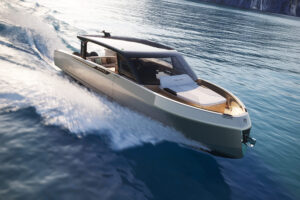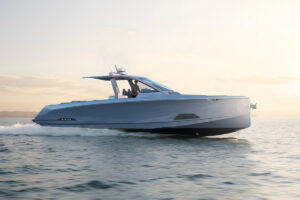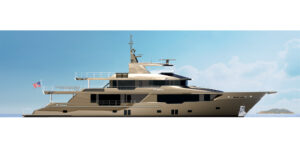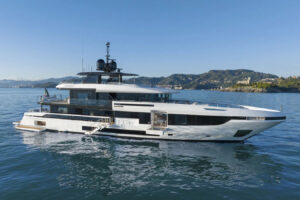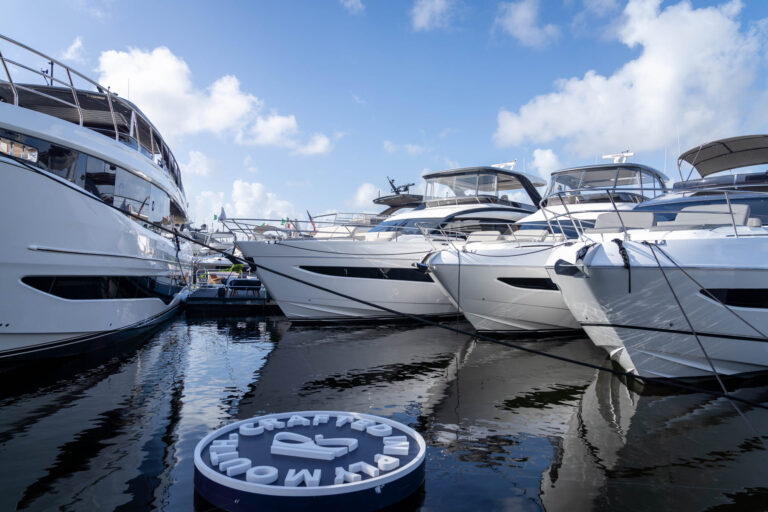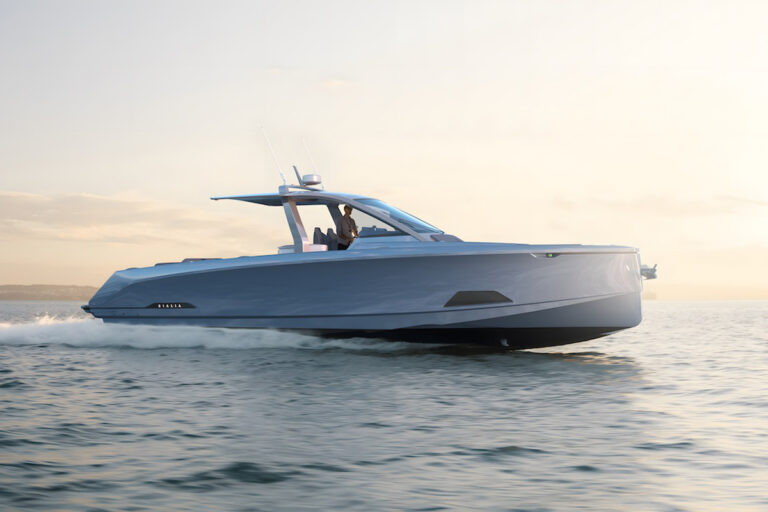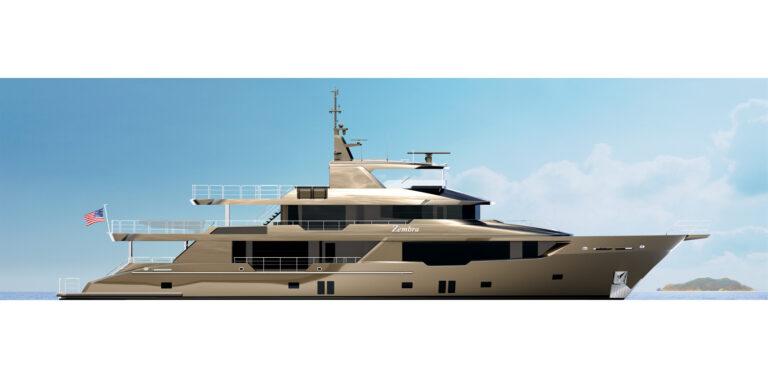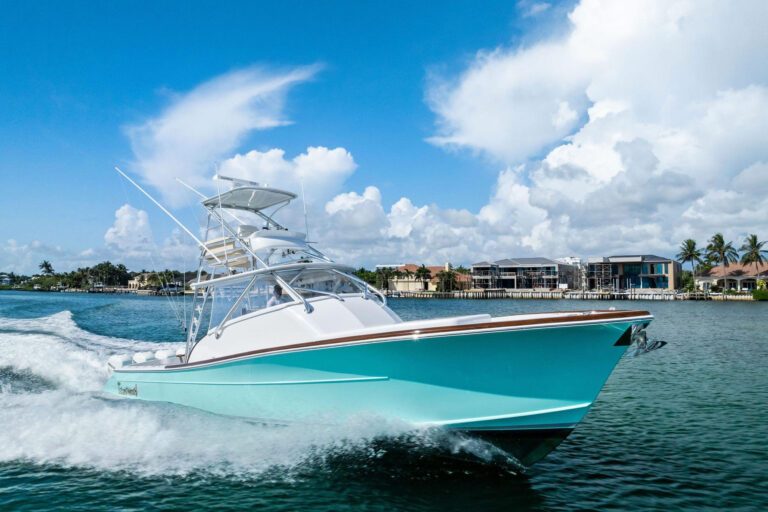
We were floating in about 10 feet of crystal clear water when I tripped the switch to let the anchor drop down on the large patch of white sand just under our bow. Ryan, my younger son, and Jack, his best friend, were standing inside the foredeck’s twin bow pulpits watching the anchor descend, giving me the thumbs up sign when they saw it touch bottom.
I dropped both engines into reverse and slowly idled backwards as the chain continued to pay out. A gust of wind on the bow slewed the boat slightly to starboard, but when I momentarily took the starboard engine out of gear, the power catamaran quickly regained its orientation, so I put the starboard engine into reverse idle again. The small diesels located in the aft end of each hull were set wide apart, and handling was exquisitely simple. When I estimated that 60 to 70 feet had passed through the anchor pulpit, I halted the windlass, felt a firm tug, and slipped the engines into neutral.
“Okay, Go!” I yelled as both diesels answered my push-button command to stop running. With a couple of joyous yells, two sun-browned boys dove head first into the perfectly clear water, knifing over the top of the bow pulpit railings. My wife, Peggy, walked along the wide side deck carrying a couple of masks and snorkels, and tossed them to the guys. Donning them quickly, they disappeared like diving ducks to check the set of the anchor, then popped up to give me the thumbs up sign one more time.
This was the first time that Peggy and I had cruised in a power catamaran, and suddenly we were both wondering why it had taken us so long to try one. We’d cruised here before in tri-cabin motor yachts, but the power catamaran quickly showed us advantages we had never expected. Our 37-foot power cat was half again as beamy as the 46-foot tri-cabin we had cruised last, and that extra beam translated into more storage and living space in every cabin. If you’ve spent any time on the water in smaller, trailerable, outboard powered catamarans, and I have, believe me when I tell you that they are a completely different experience, particular when it comes to the sheer size and luxury of a power catamaran meant for cruising or chartering.
In fact, there was more on-deck space, too, from the massive foredeck ready-made for sunning to the wide aft deck complete with built in seating and table, and covered overhead by an aft extension of the flybridge deck. Not only was there lots of protection from the sun on the aft deck, but it proved to be a great place to sit and read, or have a meal, particularly during the times when occasional rain showers passed by.
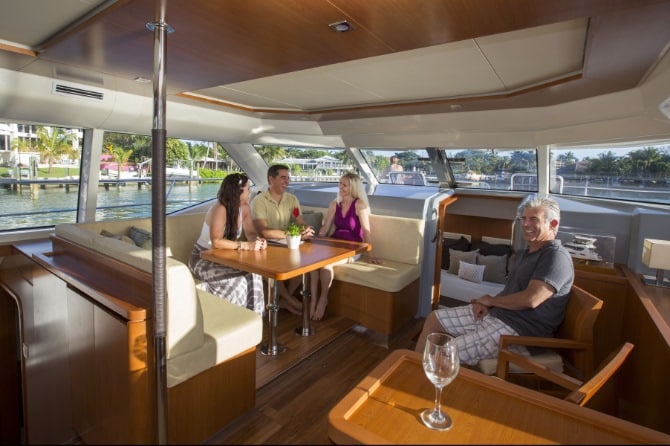
Fiberglass and teak stairs (many modern power catamaran models have molded stairs) provided with stout stainless steel handrails made getting up to or down from the flybridge positively safe. Except for those times when the rain came down, the flybridge was where we lived when underway, as well as when at anchor. The view was spectacular in every direction, making it an ideal place from which to navigate, with bimini top to protect us from too much sun, seats for all and a table for al fresco meals.
Our power catamaran had a typical owner’s layout, with a large single cabin in one hull, and twin smaller guest cabins fore and aft in the other hull. Because it was an older model, hulls on the boat we cruised, and most others at that time, were generally more narrow and deep, a condition that reflected most power cat builder’s sailing cat roots. That’s not the case any longer.
Today, most powercats, like the Morelli & Melvin of the J&J designs for Aquila, are designed from scratch as power vessels, with hulls having 3-foot-or-less drafts that really shine in shallow draft locations (think Bahamas, the Carribean, the Florida Keys). And with the proliferation of wider slips in marinas for the wider beams of today’s power catamarans and monohulls alike, it is increasingly likely that you will find a place to keep your power catamaran dockside.
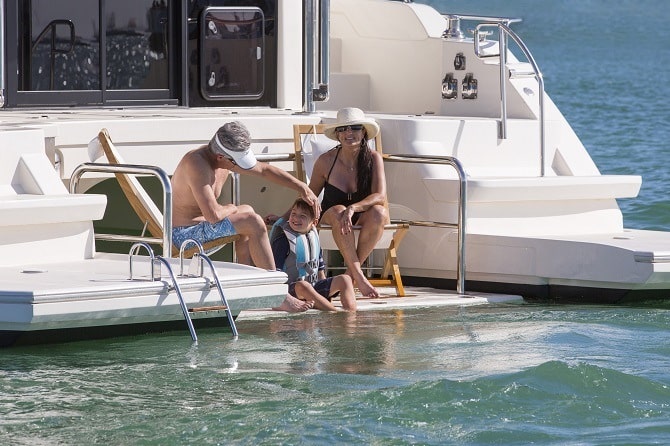
This also means added hull width for better performance and increased volume for efficient propulsion and comfort systems (think generators to power all your electrical appliances, especially air conditioning), in addition to more living room and storage capacity. In fact, the most recent Aquila design, the 44, has a master stateroom that spans nearly the full width of the 21-foot, 6-inch wide boat. And after years of cruising in monohulls, I must say that the stability of a wide, well-designed power catamaran has to be experienced to be believed.
Building materials have advanced throughout the years, and the Aquila 44 and 48 power cats are robustly built using the latest resin-infusion techniques to produce the lightest, strongest, most fuel-efficient vessels possible. For example, twin 225-hp Volvo Penta diesels push the three stateroom 44 at a brisk 17 knots, which will be appreciated when you need to make landfall quickly to escape a storm, meet a family member, exchange crew, or even keep a dinner reservation. But when you’re taking your time between not so distant anchorages, enjoying the journey at 7 to 8 knots, the 44 only burns around 2.5 gallons per hour. For more information about Aquila power catamarans, log on to www.aquilaboats.com.

